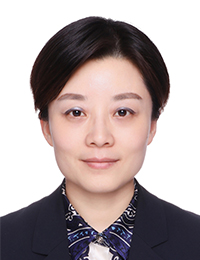Search
Close


YANG Cuixia
- Doctoral Supervisor, Professor
- Department: Laboratory Medicine
- Research Area: Clinical Diagnostics
- Research Interests: Mechanisms of metastasis and endocrine resistance in breast cancer
- Contact: dr.steven@163.com
- Deputy Director, Clinical Laboratory, Shanghai Sixth People's Hospital, 2022
- PhD from Shanghai Jiao Tong University School of Medicine, 2014
- Visiting Scholar, University of Miami School of Medicine, 2012
- MD from Qingdao University School of Medicine, 2002
- Deputy Director, Department of Clinical Laboratory, Shanghai Sixth People's Hospital
- Member of the Laboratory Medicine Branch of Shanghai Medical Association
- Representative of Shanghai Science and Technology Association
- Member of the Committee of Laboratory Medicine of Shanghai Anticancer Association
- Young Member of Immunology Technology Branch, Shanghai Society of Immunology
- Member of Tumor Markers Professional Committee of Shanghai Anticancer Association
- Member of the Oncology Working group of Shanghai Medical Doctor Association Laboratory Physician Society
- Sun X*, Tang F*, Guo Q*, Liu Y, He Y, Du Y, Gao F, Zhang G#, Yang C#. HAS2-Ezrin-ER axis plays a role in acquired antiestrogen resistance of ER-positive breast cancer. Front Pharmacol, 2022, doi: 10.3389/fphar.2022.1031487.
- Gao F*#, Zhang G*, Liu Y, He Y, Sheng Y, Sun X, Du Y, Yang C#. Activation of CD44 signaling in leader cells induced by tumor-associated macrophages drives collective detachment in luminal breast carcinomas. Cell Death Dis, 2022, doi: 10.1038/s41419-022-04986-4.
- Sheng Y*, Cao M*, Liu Y, He Y, Zhang G, Du Y, Gao F#, Yang C#. Hyaluronan synthase 2 (HAS2) regulates cell phenotype and invadopodia formation in luminal-like breast cancer cells. Mol Cell Biochem, 2021, doi: 10.1007/s11010-021-04165-7.
- Zhang G*, He Y, Liu Y, Du Y, Yang C#, Gao F#. Reduced hyaluronan cross-linking induces breast cancer malignancy in a CAF-dependent manner. Cell Death Dis, 2021, doi: 10.1038/s41419-021-03875-6.
- Hu S*, Shi X, Liu Y, He Y, Du Y, Zhang G, Yang C#, Gao F#. CD44 cross-linking increases malignancy of breast cancer via upregulation of p-Moesin. Cancer Cell Int, 2020, doi: 10.1186/s12935-020-01663-4.
- Chen X*, Shi X*, Liu Y, He Y, Du Y, Zhang G, Yang C#, Gao F#. Remodelling of the bone marrow microenvironment by stromal hyaluronan modulates the malignancy of breast cancer cells. Cell Commun Signal, 2020, doi: 10.1186/s12964-020-00592-z.
- Yang C*, Sheng Y*, Shi X, Liu Y, He Y, Du Y, Zhang G, Gao F#. CD44/HA signaling mediates acquired resistance to a PI3Kα inhibitor. Cell Death Dis, 2020, doi: 10.1038/s41419-020-03037-0.
- Yang C*, Cao M*, Liu Y, He Y, Du Y, Zhang G, Gao F#. Inducible formation of leader cells driven by CD44 switching gives rise to collective invasion and metastases in luminal breast carcinomas. Oncogene, 2019, doi: 10.1038/s41388-019-0899-y.
- Yang C*, Liu Y, He Y, Du Y, Wang W, Shi X, Gao F#. The use of HA oligosaccharide-loaded nanoparticles to breach the endogenous hyaluronan glycocalyx for breast cancer therapy. Biomaterials, 2013, doi: 10.1016/j.biomaterials.2013.05.036.
- Yang C*, Cao M*, Liu H, He Y, Xu J, Du Y, Liu Y, Wang W, Cui L, Hu J, Gao F#. The high and low molecular weight forms of hyaluronan have distinct effects on CD44 clustering. J Biol Chem, 2012, doi: 10.1074/jbc.M112.349209.
- 01/01/2023-12/31/2026
National Natural Science Foundation of China (General Program), ¥520,000, 82273462
The role and mechanism of "CD44-HA glycocalyx coat" on the surface of ER-positive breast cancer cells in endocrine therapy resistance
Role: Project leader - 01/01/2020-12/31/2023
National Natural Science Foundation of China (General Program), ¥550,000, 81974445
Activation of CD44s/v switching in the leader cells of invading breast cancer cell clusters drives the shift from collective invasive to micro-mass shedding via a cross-talk with TAMs
Role: Project leader - 01/01/2018-12/31/2020
Shanghai Municipal Health Bureau, Municipal Medical and Health Development Foundation, ¥100,000, 2017
Shanghai Outstanding Young Clinical Medical Talents (Clinical Laboratory)
Role: Project leader - 07/01/2017-06/31/2020
Shanghai Municipal Education Commission-Gaofeng Clinical Medicine Grant Support, ¥1,000,000, 20171924
Inducible formation of leader cells driven by CD44/HA gives rise to collective invasion in breast cancer
Role: Project leader - 01/01/2017-12/31/2020
National Natural Science Foundation of China (General Program), ¥540,000, 81672843
The role and mechanism of HAS2 in regulating the abnormal accumulation of HA and promoting partial EMT and stemness acquisition in invasion and metastasis of breast cancer
Role: Project leader - 01/01/2015-12/31/2017
National Natural Science Foundation of China (Younth Program), ¥230,000, 81402419
The role and mechanism of HA/CD44 in the invasion of "leader cells" in breast cancer metastasis
Role: Project leader - 07/01/2013-06/31/2014
Shanghai Jiao Tong University School of Medicine Doctoral Innovation Fund, ¥30,000, BXJ201238
Role of CD44 oligomerization mediated by HA in the formation of multidrug resistance in breast cancer
Role: Project leader - 10/01/2012-10/31/2015
Shanghai Natural Science Foundation (Younth Program), ¥100,000, 12ZR1447400
The mechanism of drug resistance induced by HA-coat in breast cancer
Role: Project leader
- [Feng Gao, Yiwen Liu, Yiqing He, Cuixia Yang, Hua Liu,] (2012), “Application and preparation of oHA-lipid-PTX nanoparticles for breast cancer therapy”; ZL 2012 1 0534240.0




